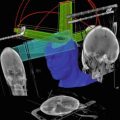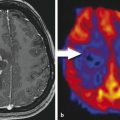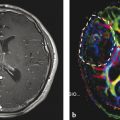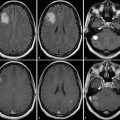© Springer-Verlag Berlin Heidelberg 2015
Elke Hattingen and Ulrich Pilatus (eds.)Brain Tumor ImagingMedical Radiology10.1007/174_2015_1072Brain Tumor Imaging
(1)
Dr. Senckenberg Institute of Neurooncology, University Cancer Center, Goethe University Hospital, Frankfurt, Germany
(2)
Department of Neurology, University Hospital Zurich, Zurich, Switzerland
Abstract
The variety of brain tumors with different histology, localization, age distribution, and prognosis might be confusing. The WHO Classification of Tumours of the Central Nervous system (2007) includes more than 100 different entities (Louis et al. 2007). The comparison of primary brain and CNS tumors by site and by histology facilitates a first insight (Ostrom et al. 2014). Moreover, this reflects the incidence rates of specific brain tumors. Besides metastatic tumors of the CNS, meningeal tumors and glioma account for more than 60 % of all primary brain tumors. Regarding malignant tumors, gliomas even represent 80 % of all primary brain tumors. From 45 years of age and older, meningioma is the most frequent and glioblastoma the second most frequent brain tumor. In children and adolescents, pilocytic astrocytoma and embryonal tumors are more relevant (Ostrom et al. 2014).
1 Introduction
1.1 Overview
The variety of brain tumors with different histology, localization, age distribution, and prognosis might be confusing. The WHO Classification of Tumours of the Central Nervous system (2007) includes more than 100 different entities (Louis et al. 2007). The comparison of primary brain and CNS tumors by site and by histology facilitates a first insight (Ostrom et al. 2014). Moreover, this reflects the incidence rates of specific brain tumors. Besides metastatic tumors of the CNS, meningeal tumors and glioma account for more than 60 % of all primary brain tumors. Regarding malignant tumors, gliomas even represent 80 % of all primary brain tumors. From 45 years of age and older, meningioma is the most frequent and glioblastoma the second most frequent brain tumor. In children and adolescents, pilocytic astrocytoma and embryonal tumors are more relevant (Ostrom et al. 2014).
Taken together, this illustrates that gliomas besides brain metastases are the most challenging entities in adult neurooncology.
Another important point is the differentiation of extra- and intracerebral localization of brain tumors. This usually allows an early distinction between meningiomas and gliomas or brain metastasis. As the clinical management differs substantially, this radiological differentiation is important. Small meningiomas in uncomplicated locations might not need an early histological diagnosis and can be followed by MRI scans. On the other hand, gliomas or brain metastasis usually need an immediate histological diagnosis. Further, the early radiological differentiation between gliomas, metastasis, and lymphomas is equally essential as the clinical management differs. For primary CNS lymphomas, steroids should be avoided before histological diagnostics and have traditionally been preferred over resection (Weller et al. 2012a). If brain metastases are suspected, systemic diagnostics are essential, and brain surgery may not always be necessary.
The current WHO classification from 2007 tries to indicate the prognosis of primary brain tumors by grading tumors from I° (benign) to IV° (malignant) primarily based on morphology (Louis et al. 2007). However, it is clear that the progress in molecular analyses will profoundly alter and refine this classification. In the future, prognostic and predictive markers and profiles will have practical importance for the vast majority of patients. Accordingly, a number of established molecular markers will be integrated in the upcoming WHO classification (Louis et al. 2014; Weller et al. 2012b, 2013; Wick et al. 2014).
In this chapter, we will focus on glioma, lymphoma, and brain metastasis.
2 Clinical Management
As the location of brain tumors is variable, the clinical presentation can be heterogeneous. Neurological or neuropsychological deficits, epileptic seizures, and symptoms of increased intracranial pressure are guiding symptoms. Symptomatic treatment includes, but is not limited to, anticonvulsive drugs for symptomatic epilepsy and dexamethasone for the treatment of symptomatic peritumoral edema (Soffietti et al. 2010; Weller et al. 2012c, 2014).
After medical history taking and the neurological examination, MRI of the brain with contrast-enhancing agent is the most important diagnostic procedure. Lumbar puncture to allow the evaluation of the cerebrospinal fluid (CSF) can be helpful in primary CNS lymphoma where tumor cells or tumor-specific molecular alterations can be detected in CSF or in germ cell tumors where elevated amounts of AFP or β-HCG can be found. In almost all other cases, the diagnosis should be confirmed via a stereotactic biopsy or, when appropriate, via resection. Despite all innovative imaging, the procurement of tumor tissue has gained particular relevance in the era of molecular diagnostic (Weller et al. 2014).
Nonetheless, innovative imaging has gained a lot of attention in the last decade. Before confirmation of the diagnosis via tissue analysis, MR spectroscopy, MR perfusion, and positron emission tomography (PET) imaging can be helpful for specific topics (Suchorska et al. 2014, 2015). Spectroscopy and perfusion can be helpful to distinguish between neoplastic lesions and other possible diagnoses. Some of the most important differential diagnoses are infectious or inflammatory causes and postischemic lesions. Moreover, metabolic imaging might show “hot spots” inside a tumor mass that can be targeted by stereotactic biopsy, thereby increasing the chance to get the most accurate diagnosis (Hermann et al. 2008). PET imaging using amino acid tracers also supports the diagnostic workup or can guide stereotactic biopsy to hot spots.
After the diagnosis has been confirmed pathologically, these innovative imaging modalities can be even more valuable. In particular, they may be useful for planning of radiotherapy (Revannasiddaiah et al. 2014). The irradiated field can be tailored to include areas with elevated PET tracer uptake, and radiation dose may be increased at hot spots seen on MR spectroscopy/perfusion or on amino acid PET.
Even more established in clinical practice is the use of innovative imaging for the monitoring during therapy and follow-up. MRI and PET can both be useful to distinguish between progressive tumor and pseudoprogression (Hutterer et al. 2014).
Functional MRI and fiber tracking using diffusion tensor imaging (DTI) might help to identify eloquent areas and improve results of surgery. Intraoperative brain mapping and awake surgery can be of further benefit. This may help to increase the extent of resection and improve progression-free survival (PFS) and overall survival (OS) while reducing perioperative morbidity.
3 Glial Tumors
3.1 Focal Glial and Glioneuronal Tumors Versus Diffuse Gliomas
Compared to focal glial tumors like pilocytic astrocytomas of the WHO grade I, grade II gliomas show diffuse infiltrative growth patterns and a propensity to evolve into grade III or grade IV gliomas. Therefore, and in contrast to pilocytic astrocytomas, a surgical cure is not possible in these (Louis et al. 2007).
Like pilocytic astrocytomas, glioneuronal tumors like dysembryoplastic neuroepithelial tumors (DNET) or ganglioglioma show a benign course. If clinically necessary, these glioneuronal tumors can usually be resected completely.
3.2 Low-Grade Versus High-Grade Gliomas
Neuropathological analyses of diffuse astrocytomas (WHO grade II) reveal well-differentiated fibrillary or gemistocytic neoplastic astrocytes on a loosely structured and often microcystic tumor matrix. Cellularity is only moderately increased. There is no mitotic activity, and proliferation rate determined by Ki-67/MIB-1 labeling index is usually below 4 % (Louis et al. 2007).
Histopathology of anaplastic astrocytomas shows the same features as those for diffuse astrocytoma. In addition, anaplastic astrocytoma shows increased cellularity, distinct nuclear atypia, and mitotic activity. Proliferation rate ranges from 5 to 10 %, but might overlap with low-grade gliomas and glioblastomas. Microvascular proliferation and necrosis are still absent (Louis et al. 2007).
Glioblastomas show a remarkable regional heterogeneity with anaplastic, poorly differentiated pleomorphic astrocytic tumor cells. Nuclear atypia is common, and mitotic activity is high. Proliferation rates range between 10 and 20 %, again with high regional heterogeneity. Microvascular proliferation and/or necrosis is essential for the diagnosis of glioblastoma (Louis et al. 2007).
Regarding prognosis, the WHO classification has obvious limitations. First, oligodendroglial tumors, anaplastic or not, have a similar clinical course that is superior to that of astrocytoma of the corresponding WHO grade. Molecular markers like 1p/19q deletions, IDH1/2 mutations, and MGMT promotor methylation are of prognostic value as they define subgroups of favorable survival. In addition, they are of predictive value and necessary for therapy decisions. It is now clear that true oligodendroglial tumors are characterized by 1p/19q codeletions and uniformly carry IDH1/2 mutations (Weller et al. 2012b, 2013; Reuss et al. 2015).
Moreover, anaplastic gliomas with favorable clinical and molecular markers can show superior survival compared to low-grade gliomas with unfavorable markers. On the other hand, anaplastic glioma with unfavorable constellation can have a prognosis inferior to that of patients with glioblastoma and favorable markers. This elucidates that molecular markers should be incorporated into an upcoming WHO classification (Louis et al. 2014; Reuss et al. 2015; Hartmann et al. 2010).
3.3 Astrocytomas Versus Oligodendroglial Tumors
In contrast to astrocytomas (see above), oligodendroglial tumor cells are monomorphic cells that show uniform round nuclei and perinuclear halos on paraffin sections (“honeycomb”). Microcalcifications, mucoid/cystic degenerations, and a dense network of branching capillaries (chicken wire) are frequently observed. Again, the presence of microvascular proliferation or necrosis is not compatible with the diagnosis of a low-grade glioma (Louis et al. 2007).
Compared to the corresponding low-grade gliomas, mitotic activity, microvascular proliferation, and areas of necrosis are frequent in anaplastic oligodendroglial tumors. A diagnosis of so-called mixed oligoastrocytoma has been established for tumors with both morphological features of oligodendroglioma and astrocytoma (Louis et al. 2007). However, the definition of oligoastrocytoma, low grade or anaplastic, is under heavy debate, and molecular markers are likely to lead to the omission of this diagnosis (Louis et al. 2007).
The mentioned calcifications in histology of oligodendroglial tumors are relevant for clinical management as they often can be detected on CT and MRI scans.
As shown by the NOA-04 trial, anaplastic oligodendroglioma and anaplastic oligoastrocytoma display a favorable outcome compared to anaplastic astrocytoma (Wick et al. 2009). This is also true for low-grade gliomas. As response rates to radiotherapy or chemotherapy in oligodendroglial tumors are higher than in astrocytic tumors, the avoidance of perioperative morbidity has even higher importance.
3.4 Low-Grade Glioma (WHO Grade II)
The absence of neurological symptoms and the presence of younger age or oligodendroglial histology are favorable clinical prognostic factors (Pignatti et al. 2002). However, even when short-term MRI scans (e.g., 3 months) suggest stable tumor size, all low-grade gliomas constantly grow in the long run (Mandonnet et al. 2003). Consequently, adjuvant treatment will be necessary at a certain time point in the course of the disease for all patients. Resection improves seizure control and may reduce the risk of malignant transformation (Soffietti et al. 2010).
3.4.1 Diffuse Astrocytoma (WHO Grade II)
After gross total resection, adjuvant treatment can be postponed at least in patients younger than 40 years of age with no neurological symptoms and a favorable location of the tumor (Pignatti et al. 2002). Regarding all other patients, there is an ongoing debate on which patients to treat and on the best time point of treatment. Radiotherapy prolongs PFS but not OS (van den Bent et al. 2005). Therefore, the EORTC defined five prognostic factors useful to identify low-risk and high-risk patients, the latter being treated with early radiotherapy (Pignatti et al. 2002). Prognostic favorable factors are age < 40 years, largest tumor diameter < 6 cm, tumor not crossing the midline, oligodendroglial or oligoastrocytic histology, and absence of a neurological deficit. Patients with two or fewer unfavorable factors are low-risk patients where therapy might be postponed unless their tumor is located in eloquent brain areas or patients suffer from untreatable epilepsy. Patients with three or more risk factors have dismal prognosis and might be treated immediately unless gross total resection was possible. In these cases, therapy might still be postponed. Chemotherapy also has activity in diffuse astrocytoma (Pace et al. 2003; Quinn et al. 2003; Brada et al. 2003). It is well established for patients who progressed after initial radiotherapy and can be an alternative as initial treatment in some patients. PCV (procarbazine, CCNU, and vincristine) and temozolomide seem to be comparable regarding efficacy with a better toxicity profile for temozolomide.
Recently, the updated results of the RTOG 9802 trial have been presented, although not published in detail yet (Shaw et al. 2012). This trial compared 54 Gy of radiotherapy with 54 Gy of radiotherapy followed by adjuvant chemotherapy with six cycles of PCV. In this regimen, procarbazine, CCNU, and vincristine are combined to a 6-week cycle. This trial included high-risk patients with low-grade glioma > 40 years of age and/or less than total resection. Median OS increased from 7.8 to 13.3 years in the combination therapy group although, interestingly, 77 % of the patients that progressed after radiotherapy had received salvage chemotherapy. A detailed analysis on histology subtypes and especially on molecular markers is lacking.
Whether these rather low-threshold criteria to define high-risk patients will translate to everyday practice is under debate. Further, it remains unanswered whether PCV alone would be equivalent and whether temozolomide could safely replace PCV in combination with radiotherapy. Therefore, many centers recommend the combination of radiotherapy and PCV.
3.4.2 Oligodendroglioma and Oligoastrocytoma (WHO Grade II)
After resection or diagnostic biopsy, the considerations for adjuvant treatment are similar to those for astrocytomas. The prognostic factors defined by the EORTC and mentioned above also apply to oligodendroglioma and oligoastrocytoma. As oligodendroglial tumors more often respond to chemotherapy, this is a more common choice for initial treatment in many centers (van den Bent et al. 1998, 2003). Nonetheless, the emerging standard of care is radiotherapy followed by chemotherapy with PCV according to the RTOG 9802 trial (Shaw et al. 2012).
3.5 Anaplastic Glioma (WHO Grade III)
In contrast to low-grade gliomas, adjuvant treatment is mandatory for patients with anaplastic glioma. The limitations of the current WHO classification are obvious in these tumors as mentioned above. Molecular markers have already entered diagnostic workup and therapeutic decision making (Weller et al. 2014).
3.5.1 Anaplastic Astrocytoma (WHO Grade III)
For adjuvant treatment, radiotherapy (60 Gy) was traditionally applied. According to the results of the NOA-04 trial, primary chemotherapy with temozolomide or with PCV seems to be equivalent regarding PFS and OS (Wick et al. 2009). Many brain tumor centers treat patients with anaplastic astrocytomas with radiochemotherapy according to the EORTC NCIC protocol with concomitant temozolomide and six cycles of adjuvant temozolomide. While reasonable, the evidence for this approach is limited and might be provided by the CATNON trial (EORTC 26053–22054). In this ongoing trial, the addition of temozolomide to first-line radiotherapy of anaplastic gliomas without 1p/19q deletion (mostly anaplastic astrocytoma) will be evaluated. In a 2 × 2 design, this study compares radiotherapy alone with radiotherapy plus concomitant temozolomide, radiotherapy plus adjuvant temozolomide, and radiotherapy plus concomitant and adjuvant temozolomide.
In the recurrent situation, treatment is less firmly established, and randomized controlled trials are rare. Second surgery might be an option if possible. Further treatment will depend on first-line treatment. Patients that progress after radiotherapy will be treated with either temozolomide chemotherapy or nitrosourea-based chemotherapy. If first-line treatment consisted of chemotherapy, radiotherapy is an option. Depending on availability, bevacizumab is often applied at progression after radiotherapy and alkylating chemotherapy, with modest PFS rates at 6 months (Weller et al. 2014).
3.5.2 Anaplastic Oligodendroglioma and Oligoastrocytoma
Radiotherapy has long been the standard of care in anaplastic oligodendroglioma and anaplastic oligoastrocytoma. However, these tumors not just frequently respond to radiotherapy, but also to chemotherapy. Especially in tumors with loss of 1p and 19q (LOH 1p/19q), PCV chemotherapy shows response rates of up to 100 % (Cairncross et al. 1994; Buckner et al. 2003). The NOA-04 trial showed that radiotherapy, PCV chemotherapy, and temozolomide are comparable in first-line treatment (Wick et al. 2009). Therefore, many centers recommended temozolomide as first-line therapy in the past, as it shows a superior tolerability profile compared to PCV. The sequence of therapeutic options (RT, PCV, TMZ) was the main focus in this trial.
In 2013, the long-term results of two large randomized controlled trials were published. Both the RTOG 9402 and the EORTC 26951 trial evaluated the combination of radiotherapy and PCV chemotherapy compared to radiotherapy alone in patients with anaplastic oligodendroglioma or oligoastrocytoma (Cairncross et al. 2006; van den Bent et al. 2006). Only after a follow-up of 6 years it became obvious that patients with LOH 1p/19q showed a dramatic benefit in OS when treated with radiotherapy and PCV (Cairncross et al. 2013; van den Bent et al. 2013). Hence, the 1p/19q status is not just prognostic but also predictive, requiring the testing for this marker before treatment planning. As for low-grade glioma, it remains unclear whether PCV alone would achieve similar results and whether temozolomide could safely replace PCV.
3.5.3 Gliomatosis Cerebri
Gliomatosis cerebri is a rare and controversial diagnosis and might be revised in future WHO classifications. This tumor cannot be defined by the neuropathologist alone. The diagnosis requires a combination of glioma histology and the radiological involvement of at least three cerebral lobes (Louis et al. 2007).
As this entity is the prototype of an infiltrative tumor, surgical resection is usually no option, and stereotactic biopsy leads to the diagnosis.
Histological features and prognosis are highly variable since any glioma histology together with radiology can lead to the diagnosis. Usually, all patients receive treatment after diagnosis.
Large randomized trials for adjuvant treatment are lacking. Radiotherapy, PCV, and temozolomide are active treatments (Herrlinger 2012; Sanson et al. 2004). Due to the diffuse growth, radiotherapy usually results in whole brain radiotherapy and is therefore frequently postponed. Instead, chemotherapy is frequently recommended for first-line treatment. The NOA-05 trial is one of the few prospective trials on chemotherapy in gliomatosis cerebri (Glas et al. 2011). Chemotherapy with PC (procarbazine + CCNU) resulted in prolonged tumor control in some patients in this trial, and the median OS was only 30 months.
3.6 Glioblastoma (WHO Grade IV)
Glioblastoma is the most frequent malignant primary brain tumor. Several studies suggest that the extent of resection is relevant for prognosis, although class I evidence is still lacking (Sanai et al. 2011; Kreth et al. 2013). Surgery using 3D navigation systems and intraoperative monitoring is standard in most centers. With 5-ALA-guided resection and intraoperative MRI, two techniques to improve extent of resection have been evaluated in a randomized controlled setting (Senft et al. 2011; Stummer et al. 2006). Both studies showed an increase of patients with gross total resection and superior survival. Awake surgery is done by some centers but cannot be regarded as a standard for patients with glioblastoma.
The current standard of care was defined in 2005 with the results of the EORTC 26981–22981 NCIC CE.3 (Stupp et al. 2005, 2009). This trial compared radiotherapy, the former standard of care, with radiotherapy plus concomitant and adjuvant chemotherapy with temozolomide. Median OS was prolonged from 12.1 to 14.6 months. Two-year survival rate increased from 10.4 to 26.5 %. In addition, a companion paper reported on the predictive value of the MGMT promoter methylation status (Hegi et al. 2005). The benefit of the addition of temozolomide was far lower when the MGMT promotor was not methylated. Patients with a methylated MGMT promotor showed a median OS of 15.3 months when they received radiotherapy alone and 21.7 months after combined treatment. Importantly, the majority of patients had alkylating agent chemotherapy at progression, diluting the survival benefit afforded by temozolomide in the experimental arm. When the MGMT promotor was unmethylated, median OS reached 11.8 and 12.7 months for radiotherapy alone and combined treatment, respectively. This benefit in patients with unmethylated MGMT promotor was small but still significant. Therefore, and because of missing alternatives as well as a certain amount of uncertainty regarding the procedures for testing the MGMT promotor, most patients are treated with a combined radiochemotherapy irrespective of the MGMT promotor status (Weller et al. 2014).
Stay updated, free articles. Join our Telegram channel

Full access? Get Clinical Tree








